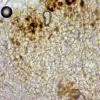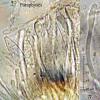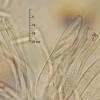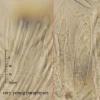
31-12-2025 19:27
Collected from loamy soil, at waterside (completel

30-12-2025 16:44
Pascal DucosBonjour,Une anamorphe rose stipitée, très nombre

30-12-2025 17:14
 Bernard CLESSE
Bernard CLESSE
Bonjour à toutes et tous,Pourriez-vous aider Albe

29-12-2025 10:15
Hulda Caroline HolteHello, I found and collected this propoloid ascom

30-12-2025 09:04
Hello.A Pyrenomycete sprouting sparsely but very d

29-12-2025 17:44
Isabelle CharissouBonjour,J'aimerais savoir si d'autres personnes au

12-11-2021 00:03
Lepista ZacariasHi everybody,A week ago in my fiels trip I noticed
Crustomollisia roburnea (Velen.) Svrček?
Enrique Rubio,
21-05-2009 20:38
What do you think?
Enrique Rubio,
21-05-2009 20:42
Enrique Rubio,
21-05-2009 20:43
Enrique Rubio,
21-05-2009 20:45
Enrique Rubio,
21-05-2009 20:46
Hans-Otto Baral,
21-05-2009 21:15

Re:Crustomollisia roburnea (Velen.) Svrček?
Dear Enrique
your fungus has many characters in common with Calycellina castanea (= Crustomollisia roburnea) which I know, however, only from Quercus (and a single time from Fagus) leaves. Apart from that, the spores have a higher lipid content in C. castanea, and, above all, the paraphyses are more inflated apically (clavate) and contain in the living state very striking VBs (vacuolar bodies). I assume your paraphyses are alive, but I am not sure. Please try a section with a razor blade and do not apply pressure, it would be important to see the living asci and especially paraphyses.
I attach photos of C. castanea made by Guy Garcia, from Quercus ilex leaves. Please compare also the images on the DVD. Besides, in your photo (ascus on the right) the crozier is very well visible, and this would fit to castanea.
Could you please send me your images in higher resolution, perhaps it helps.
Zotto
your fungus has many characters in common with Calycellina castanea (= Crustomollisia roburnea) which I know, however, only from Quercus (and a single time from Fagus) leaves. Apart from that, the spores have a higher lipid content in C. castanea, and, above all, the paraphyses are more inflated apically (clavate) and contain in the living state very striking VBs (vacuolar bodies). I assume your paraphyses are alive, but I am not sure. Please try a section with a razor blade and do not apply pressure, it would be important to see the living asci and especially paraphyses.
I attach photos of C. castanea made by Guy Garcia, from Quercus ilex leaves. Please compare also the images on the DVD. Besides, in your photo (ascus on the right) the crozier is very well visible, and this would fit to castanea.
Could you please send me your images in higher resolution, perhaps it helps.
Zotto
Enrique Rubio,
21-05-2009 21:29
Re:Crustomollisia roburnea (Velen.) Svrček?
Dear Zotto:
My fingers are too many 'fat' to try to cut so small thing. It is almost sure, that I will finish cutting my finger. Tomorrow I will look if some paraphyses has the great Vb that you say to me and i will send you my images.
Good night and many thanks
Enrique
My fingers are too many 'fat' to try to cut so small thing. It is almost sure, that I will finish cutting my finger. Tomorrow I will look if some paraphyses has the great Vb that you say to me and i will send you my images.
Good night and many thanks
Enrique
Enrique Rubio,
22-05-2009 14:13
Hans-Otto Baral,
22-05-2009 17:41

Re:Crustomollisia roburnea (Velen.) Svrček?
Dear Enrique
I have now an idea, I think it is a Pyrenopeziza! And it seems to be Pyrenopeziza betulicola Fuckel = "Orbilia" betulina (Alb. & Schw.) Höhn = Mollisia betulina (A&S) Rehm. I have examined a syntype of Calloria winteri J. Kunze which is said to be a synonym too (see Hein 1976: 108), but I made no drawing. So this seems the first record in the vital state that I see.
Zotto.
I have now an idea, I think it is a Pyrenopeziza! And it seems to be Pyrenopeziza betulicola Fuckel = "Orbilia" betulina (Alb. & Schw.) Höhn = Mollisia betulina (A&S) Rehm. I have examined a syntype of Calloria winteri J. Kunze which is said to be a synonym too (see Hein 1976: 108), but I made no drawing. So this seems the first record in the vital state that I see.
Zotto.
Enrique Rubio,
22-05-2009 18:08
Re:Crustomollisia roburnea (Velen.) Svrček?
It seems a good idea!!. I have read Fuckel's diagnosis ad I think fits well with our fngus. Only I am surprised by a thing: he says that the spores measurent 8 Mik. long and 3 Mik. broad(¿)
Hans-Otto Baral,
22-05-2009 21:43

Re:Crustomollisia roburnea (Velen.) Svrček?
I measured 10 x 2 µm in the type of Calloria winteri, but the material was apparently not well developed.
I have a note about spores 8-17 x 2-3.5 µm in an article on "P. betulicola and an anamorphic fungus growing on leaf spots of birch": Paavolainen, L. et al. (2000), Mycol. Res. 104: 611-617. I should have the copy but did not look in it.
Besides, Hein (1976) writes: 9-14 x 2.5-3 µm. So I think, considering the shrinking effect, spore size fits to yours.
Zotto
I have a note about spores 8-17 x 2-3.5 µm in an article on "P. betulicola and an anamorphic fungus growing on leaf spots of birch": Paavolainen, L. et al. (2000), Mycol. Res. 104: 611-617. I should have the copy but did not look in it.
Besides, Hein (1976) writes: 9-14 x 2.5-3 µm. So I think, considering the shrinking effect, spore size fits to yours.
Zotto
Enrique Rubio,
22-05-2009 22:09
Re:Crustomollisia roburnea (Velen.) Svrček?
Don't worry, Zotto.
I have this article. I think really our fugus is, as you say, P. betulicola.
Many thanks
I have this article. I think really our fugus is, as you say, P. betulicola.
Many thanks
Stip Helleman,
22-05-2009 23:05

Re:Crustomollisia roburnea (Velen.) Svrček?
Dear Zotto & Enrique,
I do regard Mollisia tumidila as a synonym who has a sporesize up to 13 mu long, i found this species last year. There are a few things beside the sporelength that does not fit really. this species has a Calycina type of apical apparatus and my collection is a sclerotinia type. the VBs are less refractive, in the Netherlands it seems to be a autmnale species.but the exudate on the excipulum fits well.
http://www.helotiales.nl/Species/Pyrenopeziza_betulicola.html
Cheers Stip
I do regard Mollisia tumidila as a synonym who has a sporesize up to 13 mu long, i found this species last year. There are a few things beside the sporelength that does not fit really. this species has a Calycina type of apical apparatus and my collection is a sclerotinia type. the VBs are less refractive, in the Netherlands it seems to be a autmnale species.but the exudate on the excipulum fits well.
http://www.helotiales.nl/Species/Pyrenopeziza_betulicola.html
Cheers Stip
Hans-Otto Baral,
22-05-2009 23:26

Re:Crustomollisia roburnea (Velen.) Svrček?
Yes, Stip, this tumidulum is said to be a synonym too. I paste below what I have written on it in the Orbilia monograph because one of the many combinations was in Hyalinia. Good to draw my attention to your collection. I have placed it in Microscypha monticola, another candidate for Pyrenopeziza with hyaline excipular cells. When I look at all I get quite unsure whether this could even be a further synonym of betulicola/betulina, though some of my monticola collections are on Salix leaves. Piotr Perz had recently a collection on Salix and doubts a bit that Stip's find on Betula is the same. Well - not easy! At least the spores I have drawn in my HB 3432a (DVD, Salix) remind me strongly of Enrique's collection. There was often a Venturia or Epipolaeum among the apos, also in Piotr's find.
Zotto
Here my text on tumidula:
Based on a restudy of the type material (France, Caen, leaves of Betula, M. Roberge), Arendholz (1979: 97) considered the species to be closely related to Pyrenopeziza betulicola Fuckel (see above p. ...) if not identical. He further argued that the species would fit in Pyrenopeziza Fuckel because of its ectal excipulum of t. globulosa-angularis, were not the hyaline, somewhat glassy cell walls. So he retained it as “Mollisia tumidula”. White (1943: 165) likewise treated the type material of “Helotium tumidulum” and presented a very precise figure of the hymenial elements while omitting the excipular characters. Both authors have reported the ascus apex as amyloid. The available data do not allow to conclude whether Peziza tumidula should be placed in Pyrenopeziza or Mollisia, or perhaps even in Calycellina, a genus for which, in our opinion, an ectal excipulum with or without gelatinised cell walls should be accepted. For the latter genus the raised apothecial margin covering the hymenium in the dry state does not fit.
According to White, H. tumidulum is only known with certainty from the type collection while most if not all of the material referred to this taxon by later authors has been wrongly identified.
Zotto
Here my text on tumidula:
Based on a restudy of the type material (France, Caen, leaves of Betula, M. Roberge), Arendholz (1979: 97) considered the species to be closely related to Pyrenopeziza betulicola Fuckel (see above p. ...) if not identical. He further argued that the species would fit in Pyrenopeziza Fuckel because of its ectal excipulum of t. globulosa-angularis, were not the hyaline, somewhat glassy cell walls. So he retained it as “Mollisia tumidula”. White (1943: 165) likewise treated the type material of “Helotium tumidulum” and presented a very precise figure of the hymenial elements while omitting the excipular characters. Both authors have reported the ascus apex as amyloid. The available data do not allow to conclude whether Peziza tumidula should be placed in Pyrenopeziza or Mollisia, or perhaps even in Calycellina, a genus for which, in our opinion, an ectal excipulum with or without gelatinised cell walls should be accepted. For the latter genus the raised apothecial margin covering the hymenium in the dry state does not fit.
According to White, H. tumidulum is only known with certainty from the type collection while most if not all of the material referred to this taxon by later authors has been wrongly identified.













